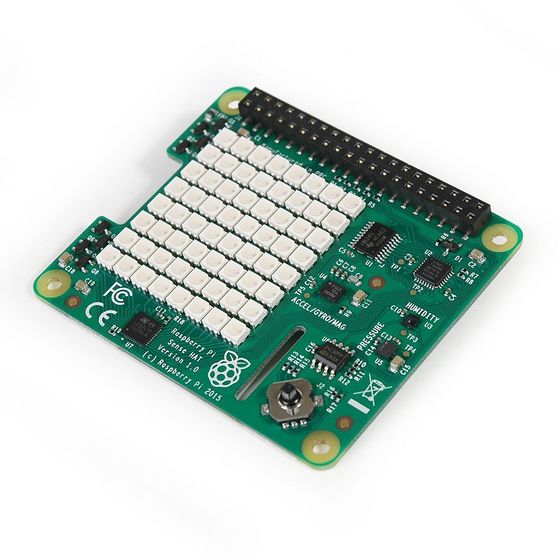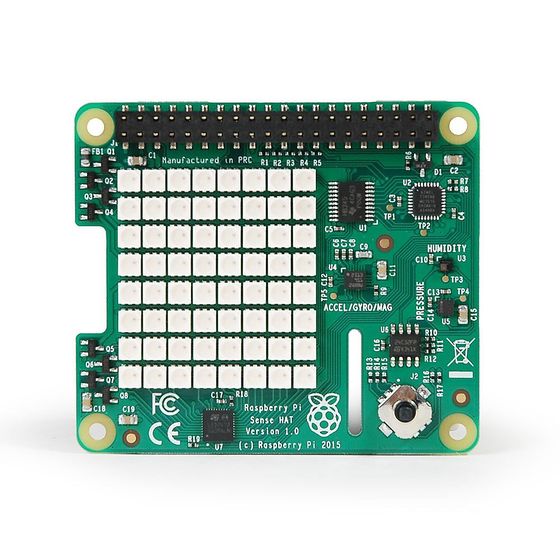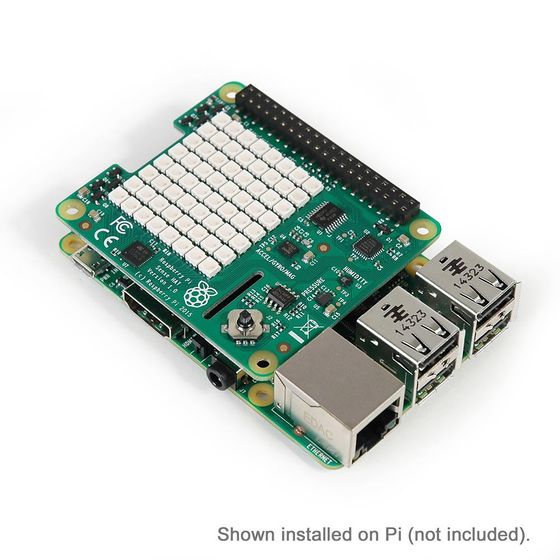Difference between revisions of "Raspberry Pi Sense HAT - AstroPi"
(Created page with "== Introduction == 560px The Raspberry Pi Sense HAT attaches via the Pi's 40pin GPIO port to read and display sensor data from a host of bu...") |
(→Technical Specifications) |
||
| (One intermediate revision by the same user not shown) | |||
| Line 9: | Line 9: | ||
[[File:712sr+1kedL._SL1000_.jpg|560px]] | [[File:712sr+1kedL._SL1000_.jpg|560px]] | ||
| − | + | == Technical Specifications == | |
| − | + | *Gyroscope - angular rate sensor: +/-245/500/2000dps | |
| − | Gyroscope - angular rate sensor: +/-245/500/2000dps | ||
| − | Accelerometer - Linear acceleration sensor: +/-2/4/8/16 g | + | *Accelerometer - Linear acceleration sensor: +/-2/4/8/16 g |
| − | Magnetometer - Magnetic Sensor: +/- 4/8/12/16 | + | *Magnetometer - Magnetic Sensor: +/- 4/8/12/16 |
| − | Gauss Barometer: 260 - 1260 hPa absolute range (accuracy depends on the temperature and pressure, +/- 0.1 hPa under normal conditions) | + | *Gauss Barometer: 260 - 1260 hPa absolute range (accuracy depends on the temperature and pressure, +/- 0.1 hPa under normal conditions) |
| − | Temperature sensor (Temperature accurate to +/- 2 degC in the 0-65 degC range) | + | *Temperature sensor (Temperature accurate to +/- 2 degC in the 0-65 degC range) |
| − | Relative Humidity sensor (accurate to +/- 4.5% in the 20-80%rH range, accurate to +/- 0.5 degC in 15-40 degC range) | + | *Relative Humidity sensor (accurate to +/- 4.5% in the 20-80%rH range, accurate to +/- 0.5 degC in 15-40 degC range) |
8x8 RGB LED matrix display Small 5 button joystick Compatible with Raspberry Pi B+, A+, and Pi 2 ASTRO PI The Raspberry Pi Sense HAT is being used in conjunction with the Raspberry Pi Foundation to perform science experiments aboard the International Space Station (ISS). For more information follow the links below: Programming the LED Screen A great tutorial and program for creating images and animations using the 8 x 8 LED matrix on the Pi Sense HAT 8 x 8 Grid Draw on Github | 8x8 RGB LED matrix display Small 5 button joystick Compatible with Raspberry Pi B+, A+, and Pi 2 ASTRO PI The Raspberry Pi Sense HAT is being used in conjunction with the Raspberry Pi Foundation to perform science experiments aboard the International Space Station (ISS). For more information follow the links below: Programming the LED Screen A great tutorial and program for creating images and animations using the 8 x 8 LED matrix on the Pi Sense HAT 8 x 8 Grid Draw on Github | ||
Latest revision as of 08:04, 5 September 2016
Introduction
The Raspberry Pi Sense HAT attaches via the Pi's 40pin GPIO port to read and display sensor data from a host of built-in sensors. Based on the same hardware that is currently in orbit on the International Space Station, the Sense HAT lets you create applications, experiments, and games.
Technical Specifications
- Gyroscope - angular rate sensor: +/-245/500/2000dps
- Accelerometer - Linear acceleration sensor: +/-2/4/8/16 g
- Magnetometer - Magnetic Sensor: +/- 4/8/12/16
- Gauss Barometer: 260 - 1260 hPa absolute range (accuracy depends on the temperature and pressure, +/- 0.1 hPa under normal conditions)
- Temperature sensor (Temperature accurate to +/- 2 degC in the 0-65 degC range)
- Relative Humidity sensor (accurate to +/- 4.5% in the 20-80%rH range, accurate to +/- 0.5 degC in 15-40 degC range)
8x8 RGB LED matrix display Small 5 button joystick Compatible with Raspberry Pi B+, A+, and Pi 2 ASTRO PI The Raspberry Pi Sense HAT is being used in conjunction with the Raspberry Pi Foundation to perform science experiments aboard the International Space Station (ISS). For more information follow the links below: Programming the LED Screen A great tutorial and program for creating images and animations using the 8 x 8 LED matrix on the Pi Sense HAT 8 x 8 Grid Draw on Github


